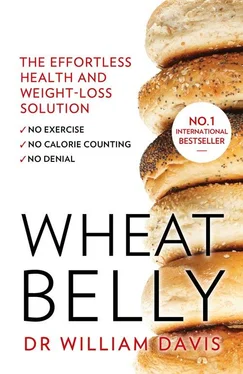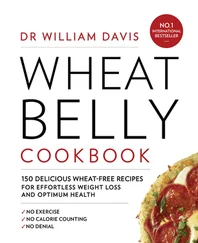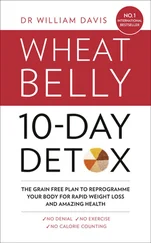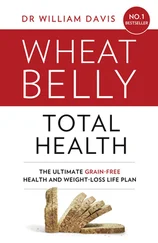The term ‘gluten’ encompasses two primary families of proteins, the gliadins and the glutenins. The gliadins, the protein group that most vigorously triggers the immune response in coeliac disease, has three subtypes: α/β-gliadins, Γ-gliadins and Ω-gliadins. Like amylopectin, glutenins are large repeating structures, or polymers, of more basic structures. The strength of dough is due to the large polymeric glutenins, a genetically programmed characteristic purposefully selected by plant breeders. 13
Gluten from one wheat strain can be quite different in structure from that of another strain. The gluten proteins produced by einkorn wheat, for example, are distinct from the gluten proteins of emmer, which are, in turn, different from the gluten proteins of Triticum aestivum . 14 , 15Because fourteen-chromosome einkorn, containing the so-called A genome (set of genes), has the smallest chromosomal set, it codes for the fewest number and variety of glutens. Twenty-eight-chromosome emmer, containing the A genome with the added B genome, codes for a larger variety of gluten. Forty-two-chromosome Triticum aestivum, with the A, B and D genomes, has the greatest gluten variety, even before any human manipulation of its breeding. Hybridisation efforts of the past fifty years have generated numerous additional changes in gluten-coding genes in Triticum aestivum , most of them purposeful modifications of the D genome that confer baking and aesthetic characteristics on flour. 16Indeed, genes located in the D genome are those most frequently pinpointed as the source of the glutens that trigger coeliac disease. 17
It is therefore the D genome of modern Triticum aestivum that, having been the focus of all manner of genetic shenanigans by plant geneticists, has accumulated substantial change in genetically determined characteristics of gluten proteins. It is also potentially the source for many of the odd health phenomena experienced by consuming humans.
IT’S NOT ALL ABOUT GLUTEN
Gluten isn’t the only potential villain lurking in wheat flour.
Beyond gluten, the other 20 per cent or so of nongluten proteins in wheat include albumins, prolamins and globulins, each of which can also vary from strain to strain. In total, there are more than a thousand other proteins that are meant to serve such functions as protecting the grain from pathogens, providing water resistance and providing reproductive functions. There are agglutinins, peroxidases, α-amylases, serpins and acyl CoA oxidases, not to mention five forms of glycerinaldehyde-3-phosphate dehydrogenases. I shouldn’t neglect to mention β-purothionin, puroindolines a and b, and starch synthases. Wheat ain’t just gluten, any more than Southern cooking is just grits.
As if this protein/enzyme smorgasbord weren’t enough, food manufacturers have also turned to fungal enzymes, such as cellulases, glucoamylases, xylanases and β-xylosidases, to enhance leavening and texture in wheat products. Many bakers also add soya flour to their dough to enhance mixing and whiteness, introducing yet another collection of proteins and enzymes.
In coeliac disease, the one conventionally accepted (though much underdiagnosed) example of wheat-related intestinal illness, gluten protein, specifically α-gliadin, provokes an immune response that inflames the small intestine, causing incapacitating abdominal cramps and diarrhoea. Treatment is simple: complete avoidance of anything containing gluten.
Beyond coeliac disease, though, there are allergic or anaphylactic (a severe reaction resulting in shock) reactions to nongluten proteins, including α-amylases, thioredoxin and glycerinaldehyde-3-phosphate dehydrogenase, along with about a dozen others. 18Exposure in susceptible individuals triggers asthma, rashes (atopic dermatitis and urticaria), and a curious and dangerous condition called wheat-dependent exercise-induced anaphylaxis (WDEIA), in which rash, asthma or anaphylaxis are provoked during exercise. WDEIA is most commonly associated with wheat (it can also occur with shellfish) and has been attributed to various Ω-gliadins and glutenins.
In short, wheat is not just a complex carbohydrate with gluten and bran. Wheat is a complex collection of biochemically unique compounds that vary widely according to genetic code. Just by looking at a poppy seed muffin, for instance, you would be unable to discern the incredible variety of gliadins, other gluten proteins and nongluten proteins contained within it, many of them unique to the modern dwarf wheat that was your muffin’s source. On taking your first bite, you would enjoy the immediate sweetness of the muffin’s amylopectin A as it sends your blood sugar skyward.
Let’s next explore the incredible wide-ranging health effects of your muffin and other wheat-containing foods.
PART TWO WHEAT AND ITS HEAD-TO-TOE DESTRUCTION OF HEALTH Chapter 4 Hey, Man, Wanna Buy Some Exorphins? The Addictive Properties of Wheat Chapter 5 Your Wheat Belly Is Showing: The Wheat/Obesity Connection Chapter 6 Hello, Intestine. It’s Me, Wheat. Wheat and Coeliac Disease Chapter 7 Diabetes Nation: Wheat and Insulin Resistance Chapter 8 Dropping Acid: Wheat as the Great pH Disrupter Chapter 9 Cataracts, Wrinkles and Dowager’s Humps: Wheat and the Ageing Process Chapter 10 My Particles Are Bigger Than Yours: Wheat and Heart Disease Chapter 11 It’s All in Your Head: Wheat and the Brain Chapter 12 Bagel Face: Wheat’s Destructive Effect on the Skin PART THREE SAY GOODBYE TO WHEAT Chapter 13 Goodbye, Wheat: Create a Healthy, Delicious, Wheat-Free Life Epilogue Appendix A Looking for Wheat in All the Wrong Places Appendix B Healthy Wheat Belly-Shrinking Recipes List of Searchable Terms Acknowledgements References About the Publisher

CHAPTER 4 Chapter 4 Hey, Man, Wanna Buy Some Exorphins? The Addictive Properties of Wheat Chapter 5 Your Wheat Belly Is Showing: The Wheat/Obesity Connection Chapter 6 Hello, Intestine. It’s Me, Wheat. Wheat and Coeliac Disease Chapter 7 Diabetes Nation: Wheat and Insulin Resistance Chapter 8 Dropping Acid: Wheat as the Great pH Disrupter Chapter 9 Cataracts, Wrinkles and Dowager’s Humps: Wheat and the Ageing Process Chapter 10 My Particles Are Bigger Than Yours: Wheat and Heart Disease Chapter 11 It’s All in Your Head: Wheat and the Brain Chapter 12 Bagel Face: Wheat’s Destructive Effect on the Skin PART THREE SAY GOODBYE TO WHEAT Chapter 13 Goodbye, Wheat: Create a Healthy, Delicious, Wheat-Free Life Epilogue Appendix A Looking for Wheat in All the Wrong Places Appendix B Healthy Wheat Belly-Shrinking Recipes List of Searchable Terms Acknowledgements References About the Publisher
HEY, MAN, WANNA BUY SOME EXORPHINS? THE ADDICTIVE PROPERTIES OF WHEAT Chapter 4 Hey, Man, Wanna Buy Some Exorphins? The Addictive Properties of Wheat Chapter 5 Your Wheat Belly Is Showing: The Wheat/Obesity Connection Chapter 6 Hello, Intestine. It’s Me, Wheat. Wheat and Coeliac Disease Chapter 7 Diabetes Nation: Wheat and Insulin Resistance Chapter 8 Dropping Acid: Wheat as the Great pH Disrupter Chapter 9 Cataracts, Wrinkles and Dowager’s Humps: Wheat and the Ageing Process Chapter 10 My Particles Are Bigger Than Yours: Wheat and Heart Disease Chapter 11 It’s All in Your Head: Wheat and the Brain Chapter 12 Bagel Face: Wheat’s Destructive Effect on the Skin PART THREE SAY GOODBYE TO WHEAT Chapter 13 Goodbye, Wheat: Create a Healthy, Delicious, Wheat-Free Life Epilogue Appendix A Looking for Wheat in All the Wrong Places Appendix B Healthy Wheat Belly-Shrinking Recipes List of Searchable Terms Acknowledgements References About the Publisher
ADDICTION. WITHDRAWAL. DELUSIONS. Hallucinations. I’m not describing mental illness or a scene from One Flew Over the Cuckoo’s Nest . I’m talking about this food you invite into your kitchen, share with friends and dunk in your tea.
Читать дальше













